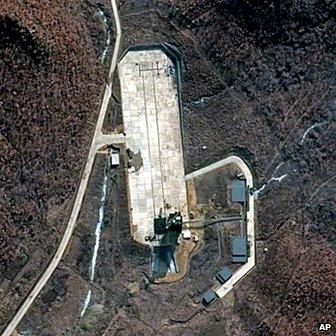Japan will intercept N Korean rocket if necessary
- Published

Japan says it will shoot down a North Korean rocket if necessary, as new satellite images appeared to show preparations for the launch next month.
Defence Minister Naoki Tanaka issued the order to intercept the rocket if it threatened Japan's territory.
Pyongyang says it will launch a satellite on a rocket between 12-16 April.
Satellite images taken on Wednesday indicate that work at the launch site is under way, says a US university.
Mr Tanaka had issuedan earlier orderon Tuesday to the country's defence forces to prepare ''destruction measures against ballistic missiles''.
On Friday, he told reporters in Tokyo that he had received cabinet approval to shoot down the rocket if necessary.
The country began preparing missile defence systems last week.
'Peaceful purposes'
Pyongyang said it plans to fire a rocket to put a satellite into orbit next month to mark the centennial of the birth of founding leader Kim Il-sung.
The move has sparked international criticism. North Korea claims the launch is for scientific research and ''peaceful purposes''.
But the United States and North Korea's neighbours insist it will be a disguised long-range missile test, contravening UN resolutions.
The resolutions were imposed after a similar launch in April 2009. Japan is particularly concerned as the last North Korean rocket was launched over the north of the country.
It is thought that this rocket will follow a new southern trajectory instead of a route to the east over Japan. It will now pass close to south-western Japan instead.
South Korea also warned earlier this week that it might shoot down any North Korean rocket that strayed into its territory.
US Assistant Secretary of State Kurt Campbell over the weekend said that the rocket may affect an area between Australia, Indonesia and the Philippines.
President Benigno Aquino III has expressed concern that rocket debris may fall on Philippine territory, and called on Pyongyang to abandon the launch.
US media reports say that the US is sending its sea-based X-band radar - a radar system that sits atop a floating platform - out into the Pacific to monitor the launch. Officials have confirmed the craft left Hawaii on 23 March.
The controversial launch also comes only weeks after North Korea agreed to return to talks on its nuclear programme in return for food aid from the US - a deal which is now on hold.
At the Nuclear Security Summit in Seoul earlier this week, President Barack Obama warned Pyongyang that its planned launch would only increase its isolation and lead to further sanctions.
Two missiles fired
The new satellite images, taken by a private US firm, DigitalGlobe, show that preparations are proceeding at the Tongchang-dong launch site in North Korea.
An analysis published on the38 North websiteby the US-Korea Institute at the Paul H. Nitze School of Advanced International Studies (SAIS) said that ''activity has been ongoing'' at the site since last week.
''Unless some major setback occurs, the North Koreans will be able to launch during the declared launch window starting 12 April 2012,'' said the article by the institute at the Johns Hopkins University.
Meanwhile, South Korean media is reporting that the North fired two short-range missiles, believed to be surface-to-ship missiles, on Thursday.
The test firing of the KN-01 missiles took place off the west coast in North Pyongan Province, the newspapers reported on Friday, citing military sources in South Korea.
The incident did not appear to be related to the upcoming rocket launch, the sources said.
Military officers believed that the move was a warning by Pyongyang to South Korean and US military, theChosun Ilbonewspaper reported.